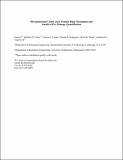Micropatterned comet assay enables high throughput and sensitive DNA damage quantification
Author(s)
Engelward, B. P.; Ge, Jing; Chow, Danielle N.; Fessler, Jessica L.; Weingeist, David M.; Wood, David K.; Engelward, Bevin P.; ... Show more Show less
DownloadEngelward_Micropatterned with tables and figures.pdf (5.459Mb)
OPEN_ACCESS_POLICY
Open Access Policy
Creative Commons Attribution-Noncommercial-Share Alike
Terms of use
Metadata
Show full item recordAbstract
The single cell gel electrophoresis assay, also known as the comet assay, is a versatile method for measuring many classes of DNA damage, including base damage, abasic sites, single strand breaks and double strand breaks. However, limited throughput and difficulties with reproducibility have limited its utility, particularly for clinical and epidemiological studies. To address these limitations, we created a microarray comet assay. The use of a micrometer scale array of cells increases the number of analysable comets per square centimetre and enables automated imaging and analysis. In addition, the platform is compatible with standard 24- and 96-well plate formats. Here, we have assessed the consistency and sensitivity of the microarray comet assay. We showed that the linear detection range for H[subscript 2]O[subscript 2]-induced DNA damage in human lymphoblastoid cells is between 30 and 100 μM, and that within this range, inter-sample coefficient of variance was between 5 and 10%. Importantly, only 20 comets were required to detect a statistically significant induction of DNA damage for doses within the linear range. We also evaluated sample-to-sample and experiment-to-experiment variation and found that for both conditions, the coefficient of variation was lower than what has been reported for the traditional comet assay. Finally, we also show that the assay can be performed using a 4× objective (rather than the standard 10× objective for the traditional assay). This adjustment combined with the microarray format makes it possible to capture more than 50 analysable comets in a single image, which can then be automatically analysed using in-house software. Overall, throughput is increased more than 100-fold compared to the traditional assay. Together, the results presented here demonstrate key advances in comet assay technology that improve the throughput, sensitivity, and robustness, thus enabling larger scale clinical and epidemiological studies.
Date issued
2014-12Department
Massachusetts Institute of Technology. Department of Biological EngineeringJournal
Mutagenesis
Publisher
Oxford University Press
Citation
Ge, J., D. N. Chow, J. L. Fessler, D. M. Weingeist, D. K. Wood, and B. P. Engelward. “Micropatterned Comet Assay Enables High Throughput and Sensitive DNA Damage Quantification.” Mutagenesis 30, no. 1 (December 19, 2014): 11–19.
Version: Author's final manuscript
ISSN
0267-8357
1464-3804